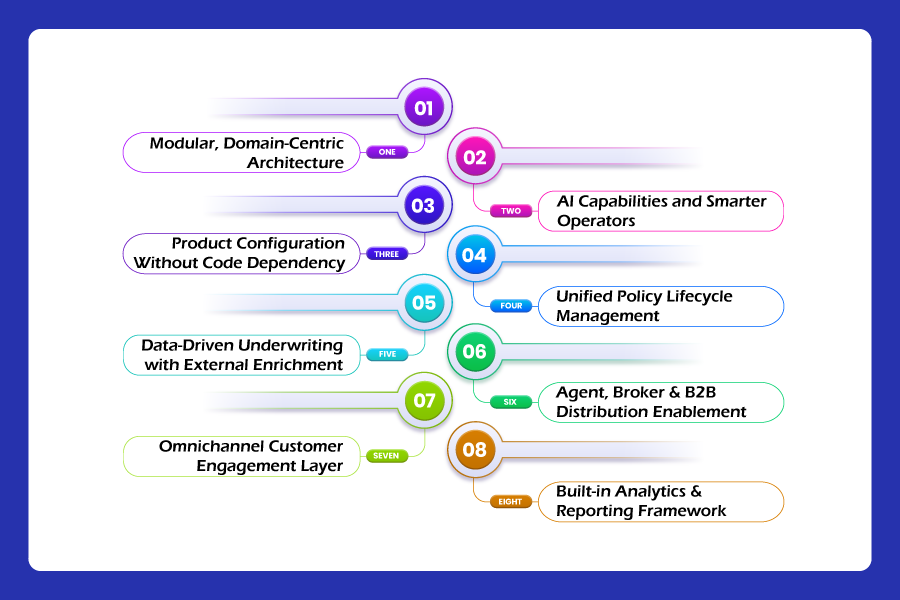
52% of insurers identify legacy systems as ‘a significant hurdle’ in improving the policyholder experience – fact.
To facilitate this convenience, more insurance companies are relying on digital insurance industry software solutions. In the modern world, it is a cornerstone of product strategy, customer experience, operational stability, and regulatory compliance for insurance companies.
But not all digital insurance solutions are built the same. Some are rooted in their legacy systems with temporary upgrades. Others are rigid products that limit business agility. Then, what does an ideal insurance distribution platform look like?
Let’s discuss the top non-negotiable features that define a truly modern, business- and customer-centric digital insurance platform in this blog.
List of Must-Have Features in an Insurance Tech Platform

A prominent insurance distribution platform lets you design, deliver, and evolve your digital insurance solutions with speed, security, and strategic control. Its functionalities are exceptional, with must-have features like:
1. Modular, Domain-Centric Architecture
Insurance is a rule-heavy domain. The systems you adopt must reflect your line of business logic, be it life, health, motor, or commercial, without excessive hardcoding or vendor dependency.
A modular architecture lets you build your tech stack as components: policy issuance, underwriting, endorsements, claims, reinsurance, agent servicing, and more. Each module can evolve independently and plug into others through APIs.
Why It Matters
- Faster time-to-market for new products or geographies.
- Isolation of risks, a bug in one module doesn’t take down the entire system.
- Tech stack agility, swap out or scale modules as needed.
Bonus Tip: Ensure the platform supports DDD (Domain-Driven Design) principles and cloud-native deployment patterns.
2. AI Capabilities and Smarter Operators
A robust digital insurance platform must have integrated AI capabilities that can enhance the core functionalities without impacting the workflow pace. From risk assessment during underwriting to detecting anomalies that indicate potential fraud, AI covers it all and fosters speed and accuracy.
Why It Matters
- It allows insurers to make faster, more confident decisions, minimize manual intervention, and deliver a smarter, more seamless experience to customers.
3. Product Configuration Without Code Dependency
Launching a new policy or making random changes shouldn’t require a six-week tech sprint. Today’s digital insurance solution for insurers requires the ability to define, test, and launch new products or variations quickly, often within days. This is only possible if the platform offers a visual product builder that empowers business users to:
- Set premium rules
- Define eligibility criteria
- Configure optional add-ons
- Localize T&Cs
- Simulate pricing and risk impacts
Why It Matters
- Product innovation becomes business-owned, not tech-gated.
- Significant reduction in go-live timelines.
- Ability to respond faster to regulatory or market changes.
4. Unified Policy Lifecycle Management
Many insurers still rely on fragmented systems for managing new business, renewals, endorsements, and cancellations, leading to inconsistent customer experiences and operational inefficiencies. A modern digital platform must manage the full policy lifecycle within a single environment. It helps digital distribution platforms with:
- Multi-product, multi-term, multi-currency support.
- Built-in workflows for endorsements and mid-term adjustments.
- Automated policy issuance and documentation.
- Version control and policy history tracking.
Why It Matters
- Elimination of redundant data entries across systems.
- Smooth handling of endorsements or reinstatements.
- End-to-end policy visibility across teams and customers.
5. Data-Driven Underwriting with External Enrichment
Underwriting should no longer rely solely on application forms and agent input. Insurers must now leverage predictive models, third-party data, and behavioral insights to refine risk assessment.
The Platform Must Support
- Rule-based and AI-enhanced underwriting engines.
- External data integrations (credit scores, health APIs, telematics, etc.).
- Dynamic underwriting decisions based on applicant profile, location, and real-time data.
Why It Matters
- More accurate pricing and risk segmentation.
- Streamlined underwriting for low-risk, high-volume cases.
- Fraud risk is flagged earlier in the customer journey.
6. Agent, Broker & B2B Distribution Enablement
Your platform isn’t just for customers; it must empower your agents, brokers, and B2B partners with the tools they need to drive business efficiently.
Key Tools Required
- Digital onboarding of intermediaries with KYC.
- Commission rule engine with real-time visibility.
- Custom quote generation, document printing, and servicing.
- Performance tracking and portfolio management dashboards.
Why It Matters
- Improved distribution network performance.
- Lower dependence on backend operations.
- Better relationship management with key intermediaries.
7. Omnichannel Customer Engagement Layer
Customers expect insurers to be available and responsive across diverse channels. It can be it mobile apps, WhatsApp, email, or web portals. What’s more, they expect consistency and a seamless experience. Insurance digitalization must:
Look For Platforms That Enable
- White-labeled customer self-service portals.
- Native and cross-platform mobile applications.
- API-driven chatbot and voice assistant integration.
- Notifications, reminders, and nudges via SMS, email, or push.
Why It Matters
- Lower call center volumes through self-service.
- Higher NPS scores due to real-time updates.
- Improved renewal and upsell conversion rates.
8. Built-in Analytics & Reporting Framework
Data is at the core of every smart insurance decision, be it reserving, pricing, cross-selling, or operations. Hence, a digital insurance company should ensure that:
Your Software Must Have
- Real-time operational dashboards (claims status, policy pipeline, etc.).
- Configurable MIS reports and product-specific views.
- KPIs around lapse rates, Turnaround Times (TATs), loss ratios, and persistency.
- Integrated AI for future analytics deployments (e.g., churn prediction).
Why It Matters
- Faster response to performance issues or fraud trends.
- Better decisions on reinsurance and reserving.
- Marketing and distribution alignment through actual data.
9. Compliance and Audit Control Framework
Insurance is a heavily regulated industry, and with insurance distribution management comes the responsibility to adhere to the regulatory frameworks. A future-proof digital solution must include configurable compliance frameworks to handle region-specific rules and audit needs.
Look for
- In-built regulatory reporting formats (IRDAI, MAS, etc.)
- Role-based access logs and complete audit trails
- Secure data residency and encryption configurations
- Policy and document archival with retrieval control
Why It Matters
- Fewer compliance escalations
- Smooth audit trails and data governance
- Easier scalability across regulatory jurisdictions
10. API Ecosystem and Integration-Readiness
The insurance distribution ecosystem today comprises TPAs, banks, digital partners, health platforms, vehicle databases, and more. Your software must be API-first so that you can connect, embed, or extend your offerings easily.
Ideal Capabilities
- Standardized REST APIs for quote, bind, issue, claim, and renewal.
- Developer sandbox and documentation portals.
- Integration libraries for payment, CRM, DMS, and analytics platforms.
Why It Matters
- Expand to new partnerships without major tech investments.
- Enable embedded insurance and contextual offerings.
- Increase policy volume through third-party distribution.
11. Multi-Tenant, Multi-Geo Deployment Capability
If you’re an insurer operating in multiple regions, your insurance distribution management setup must be robust. The platform must allow you to manage separate product rules, tax logic, regulatory norms, and user access, all while keeping costs in check.
You Need
- Single codebase, multi-entity deployment.
- Geo-specific localization (language, currency, time zones).
- Configurable branding and documentation for each unit.
Why It Matters
- Simpler scaling across countries or business units
- Centralized oversight with localized flexibility
- Lower IT and operations overhead
All these features must be highly considered if you acquire modern insurance distribution software solutions. Moreover, what matters more is how well your system keeps up with the real-world demands.
Final Words
The success of a digital insurance transformation doesn’t lie in sophisticated apps or chatbot experiments. It lies in building a foundational system that supports speed, product agility, customer-centricity, and compliance, without compromising control.
The right insurance distribution software platform becomes your competitive edge. However, it is only possible if it reduces time for product launches, elevates customer experience, streamlines claims, and empowers data-driven growth.
Ensurite is a digital distribution of insurance software solution that brings together domain expertise, future-focused technology, and business understanding to help insurers, reinsurers, and even agents scale smarter, sell faster, and serve better. If you’re looking to invest in a digital insurance solution that grows with your business, now and for the next decade, our team would love to assist you, just get in touch with us.
Explore more Blogs: https://ensurite.ai/blog/
Frequently Asked Questions
How do customer self-service portals benefit insurers and reinsurers?
Customer self-service portals are highly beneficial for both insurers and reinsurers. It helps with an elevated customer experience, improved operational efficiency, and cost-cutting. Moreover, it also empowers customers to manage their policies, track claims, and access information regarding their policies. For insurers, it results in reduced calls, enables them with faster processing time, helps them acquire accurate data, and fosters operational productivity.
What role does AI play in digital insurance solutions?
In the modern insurance market, AI (artificial intelligence) has become a must-have feature of digital insurance solutions. It helps insurance companies with automated processes to collect and analyze massive data, reduce fraud, automate repetitive tasks, and provide personalized customer support.
Is regulatory compliance management included in insurance software?
Yes, regulatory compliance management is included in insurance software solutions. These systems are designed to stay updated with changing laws and industry standards. They also help automate reporting and audit trails, reducing the risk of non-compliance.
Can insurance software integrate with legacy systems?
Yes, insurance software can integrate with conventional insurance systems; however, it might not be as effective as it is with modern insurance setups. Integration often requires custom APIs or middleware to ensure smooth data exchange. Despite the complexity, it helps insurers modernize operations without a complete system overhaul.
